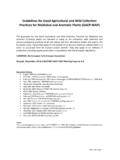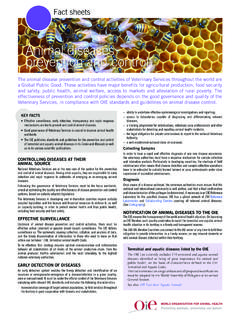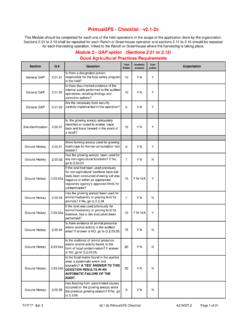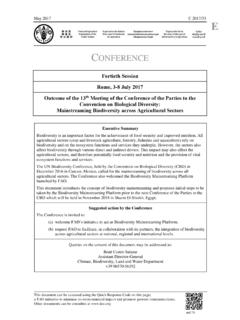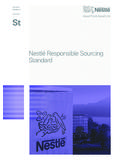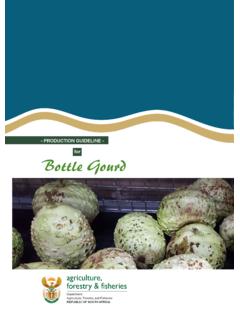Transcription of Water sampling and analysis - WHO
1 4. Water sampling AND sampling and analysisIdeally, a laboratory infrastructure should be established which will enable allsamples to be returned to a central or regional laboratory within a few hours ofbeing taken. However, this depends on the availability of a good road system andof reliable motorized transport for all sampling officers, and these are not availablein many countries. Thus, although it may be possible to establish well-equippedcentral and even regional laboratories for Water analysis , at the provincial anddistrict levels it may be necessary to rely on a relatively small number of simpletests. As noted in Chapter 1, this approach is sometimes called critical-parameterwater most important factor to take into account is that, in most communities,the principal risk to human health derives from faecal contamination. In somecountries there may also be hazards associated with specific chemical contami-nants such as fluoride or arsenic, but the levels of these substances are unlikely tochange significantly with time.
2 Thus, if a full range of chemical analyses isundertaken on new Water sources and repeated thereafter at fairly long intervals,chemical contaminants are unlikely to present an unrecognized hazard. In con-trast, the potential for faecal contamination in untreated or inadequately treatedcommunity supplies is always present. The minimum level of analysis shouldtherefore include testing for indicators of faecal pollution (thermotolerant (faecal)coliforms), turbidity, and chlorine residual and pH (if the Water is disinfectedwith chlorine).Even in developing countries poorly served by roads and transportation, it isusually possible to devise a rational sampling and analytical strategy. This shouldincorporate carefully selected critical-parameter tests in remote (usually rural)locations using simple methods and portable Water -testing equipment (see 66) where appropriate.
3 Wherever possible the community should be involvedin the sampling process. Where Water is disinfected, primary health workers,schoolteachers, and sometimes community members can be trained to carry outsimple chlorine residual testing. The same people could also collect samples forphysicochemical analysis and arrange for their delivery to the regional use of community members in this way has significant implications fortraining and supervision but would be one way of ensuring more completesurveillance FOR DRINKING- Water SamplingThe guidelines provided here take into account experience in surveillanceprogrammes in remote, typically rural, areas and in periurban general advice on sampling is given in Volume 1 and in ISO standards (seethe Bibliography). Location of sampling pointsOne objective of surveillance is to assess the quality of the Water supplied by thesupply agency and of that at the point of use, so that samples of both should betaken.
4 Any significant difference between the two has important implications forremedial must be taken from locations that are representative of the watersource, treatment plant, storage facilities, distribution network, points at whichwater is delivered to the consumer, and points of use. In selecting samplingpoints, each locality should be considered individually; however, the followinggeneral criteria are usually applicable: sampling points should be selected such that the samples taken are represen-tative of the different sources from which Water is obtained by the public orenters the system. These points should include those that yield samples representative of theconditions at the most unfavourable sources or places in the supply system,particularly points of possible contamination such as unprotected sources,loops, reservoirs, low-pressure zones, ends of the system, etc.
5 sampling points should be uniformly distributed throughout a piped distri-bution system, taking population distribution into account; the number ofsampling points should be proportional to the number of links or branches. The points chosen should generally yield samples that are representative ofthe system as a whole and of its main components. sampling points should be located in such a way that Water can be sampledfrom reserve tanks and reservoirs, etc. In systems with more than one Water source, the locations of the samplingpoints should take account of the number of inhabitants served by eachsource. There should be at least one sampling point directly after the clean-wateroutlet from each treatment sites in a piped distribution network may be classified as: fixed and agreed with the supply agency; fixed, but not agreed with the supply agency; or random or type of sampling site has certain advantages and disadvantages.
6 Fixedsites agreed with the supplier are essential when legal action is to be used as a4. Water sampling AND ANALYSIS53means of ensuring improvement; otherwise, the supply agency may object to asample result on the grounds that Water quality may have deteriorated in thehousehold, beyond the area of responsibility of the supplier. Nevertheless, fixedsample points are rare or unknown in some sites that are not necessarily recognized by the supply agency are usedfrequently in investigations, including surveillance. They are especially usefulwhen results have to be compared over time, but they limit the possibility ofidentifying local problems such as cross-connections and contamination fromleaking distribution regimes using variable or random sites have the advantage of beingmore likely to detect local problems but are less useful for analysing changes sampling frequencyThe most important tests used in Water -quality surveillance or quality control insmall communities are those for microbiological quality (by the measurement ofindicator bacteria) and turbidity, and for free chlorine residual and pH wherechlorination is used.
7 These tests should be carried out whenever a sample is taken,regardless of how many other physical or chemical variables are to be recommended minimum frequencies for these critical measurements inunpiped Water supplies are summarized in Table and minimum samplenumbers for piped drinking- Water in the distribution system are shown in sampling methods for microbiological analysisDetailed methods for sampling for microbiological analysis are given in Annex samples should be accompanied by an appropriate collection form; a modelsample collection form is illustrated in Fig. Storage of samples for microbiological analysisAlthough recommendations vary, the time between sample collection and analy-sis should, in general, not exceed 6 hours, and 24 hours is considered the absolutemaximum. It is assumed that the samples are immediately placed in a lightproofinsulated box containing melting ice or ice-packs with Water to ensure rapidcooling.
8 If ice is not available, the transportation time must not exceed 2 is imperative that samples are kept in the dark and that cooling is rapid. If theseconditions are not met, the samples should be discarded. When Water thatcontains or may contain even traces of chlorine is sampled, the chlorine must beinactivated. If it is not, microbes may be killed during transit and an erroneousresult will be obtained. The bottles in which the samples are placed shouldtherefore contain sodium thiosulfate to neutralize any chlorine present, as de- guidelines FOR DRINKING- Water QUALITY54 Table Minimum frequency of sampling and analysis of unpiped Water suppliesSource and mode of supplyMinimum frequency of sampling and analysisRemarksBacteriologicalPhysical/c hemicalOpen wells for community supplySanitary protection measures;Once initially for community wellsPollution usually expected tobacteriological testing only ifoccursituation demandsCovered dug wells and shallowSanitary protection measures.
9 Once initially, thereafter asSituations requiring testing:tubewells with hand-pumpsbacteriological testing only ifsituation demandschange in environmentalsituation demandsconditions, outbreak ofwaterborne disease, or increasein incidence of waterbornediseasesDeep tubewells with hand-pumpsOnce initially, thereafter asOnce initially, thereafter asSituations requiring testing:situation demandssituation demandschange in environmentalconditions, outbreak ofwaterborne disease, or increasein incidence of waterbornediseasesProtected springsOnce initially, thereafter asPeriodically for residual chlorineSituations requiring testing:situation demandsif Water is chlorinatedchange in environmentalconditions, outbreak ofwaterborne disease, or increasein incidence of waterbornediseasesCommunity rainwater collectionSanitary protection measures;Not needed systemsbacteriological testing only ifsituation demands4.
10 Water sampling AND ANALYSIS55 Fig. Model sample collection formGUIDELINES FOR DRINKING- Water QUALITY56 Table Minimum sample numbers forpiped drinking- Water in thedistribution systemPopulation servedNo. of monthly samples,500015000 100 0001 per 5000 0001 per 10 000 population, plus 10additional samplesscribed in Annex 4. The box used to carry samples (see Fig. ) should be cleanedand disinfected after each use to avoid contaminating the surfaces of the bottlesand the sampler s sampling methods for physicochemical analysisResults of physicochemical analysis are of no value if the samples tested are notproperly collected and stored. This has important consequences for samplingregimes, sampling procedures, and methods of sample preservation and general, the time between sampling and analysis should be kept to a in glass or polyethylene bottles at a low temperature ( 4 C) in the darkis recommended.










